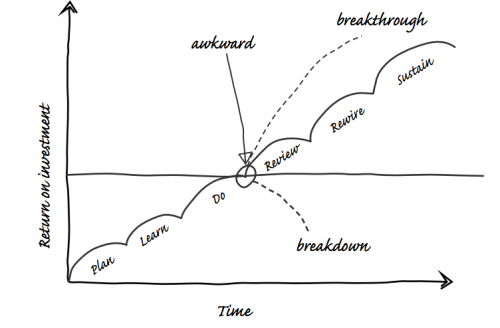Feedback is broken – and training is not enough to make change and shift cultures
Changing habits in an organisation does not happen overnight. Training programs are a good start, but how do we implement and sustain what we’ve learnt? Georgia Murch shares six steps to drive and maintain change.
Most organisations and individuals understand the value and power of giving and receiving feedback. We are aware that it builds trust and respect between our employees, customers and stakeholders. We know that great conversations lead to better outcomes and therefore productivity and profit. So we send our people to a training program in the hope they will come back a changed person.
Yet we find that our people – and if we are honest, ourselves too – still avoid it or handle it poorly.
The history of feedback
The concept of ‘performance management’ was introduced about sixty years ago as a means to determine the wages of an employee based on their performance. It was used to drive behaviours to generate specific outcomes. When employees were solely driven by financial rewards this tended to work well.
In the late 1980s not all employees felt rewarded or motivated by financial gain alone; many were driven by learning and the development of their skills. From here performance management started moving into more frequent monitoring and reviews with a focus on ‘regular feedback’ outside the formal review process.
As organisations put more regular conversations into the mix there was a notable improvement in productivity and employee engagement, when the conversations were handled expertly. In fact, the Corporate Leadership Council tells us that when informal feedback is delivered well it can improve productivity by nearly 40%. Now that’s pretty compelling.
We are now seeing an emerging trend in high-performing organisations where all employees, not just the leaders, are being taught how to give great feedback, and also how to receive feedback with equal candour and grace. Organisations that do this are in their ‘feedback flow’. But there are not enough companies using this for their competitive advantage.
Many are still running training programs in isolation in the hope it will develop their people and create a new organisation. This is as likely as going to the gym once and expecting a body transformation. When done well, it is a start, and a good one, but a start alone nevertheless.
Nelson Jackson was on to it when he said, ‘I do not believe you can do today’s job with yesterday’s methods and be in business tomorrow’.
So why aren’t all organisations focusing on improving the feedback skills of their people?
In a challenging economy it’s getting harder to justify training without proving the value, both to the individual and the organisation. This is not as difficult as you think, but it does require planning up front to understand what you want to improve and how to measure it.
Another challenge can be getting traction after the training. It can be difficult to keep the momentum to embed what they have learnt when people are either not motivated or not supported. Unless we make people accountable to implement what they have learnt, it is likely to be forgotten. We also need to make it inspiring to do so. We want people to know they are gaining time by focusing on improving, not stealing it.
Training alone is not enough to drive change
We need to get comfortable with pushing through the awkwardness of changing habits and processes to move to a breakthrough in the capability of people and to create improved cultures. Otherwise we have a breakdown and go back to old styles that often don’t serve us or the business.

Many of my clients tell me that they understand the need to push through the awkward but they are not quite sure of how to do this. If we want the change to improve over time and be sustainable, then we should consider all the elements to creating a remarkable culture.
Following is a high level guide that considers all the elements to create a sustainable culture.
Step 1: Plan
This phase is about setting the foundations for a successful rollout. What are the objectives? How do we know the program will address what we need? How can this be measured? Consider qualitative and quantitative measurements. What is the communication strategy? Who are the key stakeholders? Consider pilot programs to test the design.
Step 2: Learn
For the training component to be successful it is more than just great design. Hire remarkable facilitators and trainers. Make sure they suit your culture. Consider what methods outside the workshop you have to embed such as coaching, mentoring, online tools, etc. Make the learning highly engaging and heavily pragmatic.
Step 3: Do
It’s make or break time. Set up systems and processes where people are accountable to deliver on what they have learnt. In my space, it is about having the tough conversations. Create lots of space, in and out of the initial training, for practice. Create the right conditions and this will help people move from awkward to an outcome. If we don’t, then the return on investment is significantly lost.
Step 4: Review
Too many times we implement without measurement. Based on the foundations we set in the planning phase, we should consistently measure progress. Then report back, to engage people and the business. We also set up ‘remembering rhythms’ so people are able to recall what they have learnt easily and can put it into place.
Step 5: Rewire
We need to understand what’s working and what’s not and then tweak the implementation and change direction if required. There is no point pushing something that is not at its optimal. In particular, we can do an ‘appreciate inquiry’ to understand what’s working well and amplify it across the business.
Step 6: Sustain
We shouldn’t make the mistake of thinking we’ve made it and then drop all our good work. Whilst sustaining suggests a holding pattern, it still requires careful planning to keep people motivated and supported to be the change they seek.
If we really want to create cultures of feedback, we need to put in place a programme to embed the learning. I see too many organisations miss this opportunity to improve their return on investment on the dollars spent and time allocated post initial training. Then they wonder why people are not being the change they are looking for. Changing habits does not happen overnight. It is a planned and considered approach. And it’s not as complicated as we think.
When we get clever about how to embed the learning, change becomes effortless and the cultures is able to self-sustain.
Georgia Murch is an expert in teaching individuals how to have the tough conversations and create feedback cultures in organisations. She is the author of ‘Fixing Feedback’ and a highly engaging speaker. Visit www.georgiamurch.com or email georgia@georgiamurch.com













